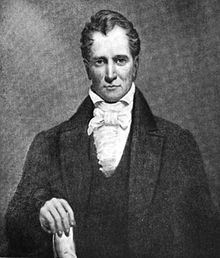Gideon Tomlinson
Gideon Tomlinson | |
|---|---|
 | |
| United States Senator from Connecticut | |
| In office March 4, 1831 – March 3, 1837 | |
| Preceded by | Calvin Willey |
| Succeeded by | Perry Smith |
| 25th Governor of Connecticut | |
| In office May 2, 1827 – March 2, 1831 | |
| Lieutenant | John Samuel Peters |
| Preceded by | Oliver Wolcott, Jr. |
| Succeeded by | John Samuel Peters |
| Member of the U.S. House of Representatives from Connecticut's at-large district | |
| In office March 4, 1819 – March 3, 1827 | |
| Preceded by | Thomas S. Williams |
| Succeeded by | David Plant |
| Personal details | |
| Born | December 31, 1780 Stratford, Connecticut |
| Died | October 8, 1854 (aged 73) Fairfield, Connecticut |
| Political party | Toleration (1817-1827) Democratic-Republican (1827-1828) National Republican (1828-1834) Whig (1834-1854)[1] |
| Spouse(s) | Sarah Bradley Tomlinson, Lydia Ann Wells Wright Tomlinson |
| Children | Jabez Huntington Tomlinson |
| Alma mater | Yale College |
| Profession | lawyer, politician |
Gideon Tomlinson (December 31, 1780 – October 8, 1854) was a United States Senator, United States Representative, and the 25th Governor for the state of Connecticut.
Biography[]
Born in Stratford,[2] Tomlinson completed preparatory studies and graduated from Yale College in 1802.[3] He went to Virginia for a year to be a private tutor and to study law. When he returned to Fairfield he continued his studies and was admitted to the bar in 1807. That same year he married Sarah Bradley. He received a Master of Arts, in 1808 from Yale. Their only child, Jabez Huntington Tomlinson, was born in 1818 but died at the young age of 19 in 1838. Mrs. Tomlinson died in 1842. In 1846, Gideon married Mrs. Lydia Ann Wells Wright, widow of William Wright of Bridgeport, Connecticut.[4]
Career[]
Tomlinson entered politics in 1817, as clerk of the Connecticut House of Representatives, and was reelected again in 1818, when he served as speaker. He was Delegate to the State Constitutional Convention in 1818.
Elected to the Sixteenth and to the three succeeding United States Congresses, Tomlinson served as a Representative from March 4, 1819 to March 3, 1827, and was chairman of the Committee on Commerce (Nineteenth Congress).[5]
Winning the 1827 gubernatorial nomination, Tomlinson was elected Connecticut's eighth governor. He was reelected to the governor's office in 1828, 1829, and 1830. During his tenure, prison reform was accomplished in 1827 with the opening of a more civilized penitentiary. His administration advocated educational improvements and fiscal support to the public school system. On March 2, 1831, Tomlinson resigned from office to accept an appointment to the U.S. Senate.[6]
Tomlinson served in the United States Senate and served from March 4, 1831, to March 3, 1837. There, he served as chairman of the Committee on Pensions (Twenty-third and Twenty-fourth Congresses).[5] In 1837, he left the Senate and became the first President of the newly chartered Housatonic Railroad Company.
He was a trustee of Trinity College, then retired to private life.
Death and legacy[]
Tomlinson died in Fairfield on October 8, 1854. He is interred at the Old Congregational Cemetery, Stratford, Connecticut. The Tomlinson Bridge (built 1796-98) of Fair Haven (part of New Haven) Connecticut is named after him. The Tomlinson Middle School in Fairfield is named in his honor.
References[]
- ^ "Gideon Tomlinson". Museum of Connecticut History. Retrieved 16 September 2020.
- ^ "Gideon Tomlinson". The Political Graveyard. Retrieved 26 November 2012.
- ^ "Gideon Tomlinson". Biographical Directory of the United States Congress. Retrieved 26 November 2012.
- ^ "Gideon Tomlinson". Connecticut State Library. Archived from the original on 18 October 2012. Retrieved 26 November 2012.
- ^ Jump up to: a b "Gideon Tomlinson". Govtrack US Congress. Retrieved 26 November 2012.
- ^ "Gideon Tomlinson". National Governors Association. Retrieved 26 November 2012.
External links[]
- United States Congress. "Gideon Tomlinson (id: T000300)". Biographical Directory of the United States Congress.
- . Appletons' Cyclopædia of American Biography. 1889.
- Connecticut State Library
- Gideon Tomlinson at Find a Grave
- The Political Graveyard
- Govtrack US Congress
- National Governors Association
- 1780 births
- 1854 deaths
- People from Stratford, Connecticut
- Democratic-Republican Party members of the United States House of Representatives from Connecticut
- Toleration Party politicians
- National Republican Party members of the United States House of Representatives from Connecticut
- National Republican Party United States senators from Connecticut
- Governors of Connecticut
- National Republican Party state governors of the United States
- Connecticut Whigs
- Members of the Connecticut House of Representatives
- Lawyers from Fairfield, Connecticut
- Yale College alumni
- 19th-century American lawyers

